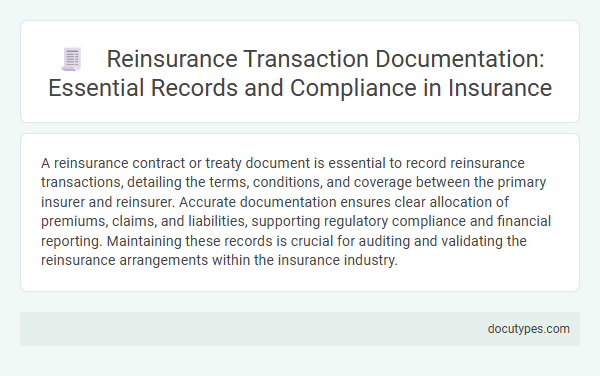A reinsurance contract or treaty document is essential to record reinsurance transactions, detailing the terms, conditions, and coverage between the primary insurer and reinsurer. Accurate documentation ensures clear allocation of premiums, claims, and liabilities, supporting regulatory compliance and financial reporting. Maintaining these records is crucial for auditing and validating the reinsurance arrangements within the insurance industry.
Introduction to Reinsurance Transaction Documentation
Reinsurance transaction documentation is essential to properly record and manage the transfer of risk between insurers. It provides clarity regarding the terms, conditions, and obligations of both parties involved in the agreement.
Your insurance company requires specific documents to ensure compliance and accurate accounting of reinsurance transactions. Key documents include the reinsurance contract, covering the scope and responsibilities, and the bordereau, detailing premium and claim data. Maintaining these records supports transparency and helps validate financial and risk management practices.
Key Components of Reinsurance Agreements
Recording reinsurance transactions requires precise documentation that outlines the terms and conditions agreed upon by the insurer and reinsurer. The core document is the reinsurance agreement, which serves as the legal foundation for all transactions and claims.
- Reinsurance Agreement - A legally binding contract detailing the scope, coverage limits, premiums, and obligations of both parties.
- Certificate of Reinsurance - A document issued to verify the coverage provided by the reinsurer to the ceding insurer.
- Loss and Premium Reports - Regular reports submitted to track claims, losses, and premiums to ensure accurate financial accounting.
Mandatory Documentation for Reinsurance Contracts
```htmlAccurate documentation is essential to record reinsurance transactions and ensure compliance with regulatory standards. You must maintain specific mandatory documents that detail the terms and conditions of the reinsurance contracts.
- Reinsurance Agreement - A formal contract outlining the obligations and coverage between the ceding insurer and the reinsurer.
- Statement of Account - A record detailing premiums, claims, and commissions exchanged during the reinsurance period.
- Evidence of Risk Transfer - Documentation proving the transfer of risk, such as underwriting files or risk assessment reports, necessary for financial reporting accuracy.
Due Diligence Records in Reinsurance Transactions
Due diligence records are essential documents required to record reinsurance transactions accurately. These records ensure that all parties involved have verified the financial stability and credibility of the reinsurer.
Such documentation typically includes financial statements, compliance certificates, and underwriting guidelines. Maintaining thorough due diligence records helps mitigate risks and supports regulatory compliance in the reinsurance process.
Regulatory Compliance in Reinsurance Documentation
Reinsurance transactions require detailed contracts known as reinsurance treaties or agreements to ensure regulatory compliance. These documents outline the terms, conditions, and coverage limits, providing legal proof of risk transfer between the ceding insurer and reinsurer. Regulatory bodies mandate maintaining these records to verify adherence to financial reporting standards and solvency requirements.
Recordkeeping Standards for Reinsurance Operations
What document is required to record reinsurance transactions? A reinsurance contract is essential for documenting the terms and obligations between ceding and assuming insurers. Accurate recordkeeping ensures compliance with regulatory standards and supports financial reporting.
Audit Trails and Documentation Best Practices
Recording reinsurance transactions requires detailed documentation such as ceding and assuming company agreements, reinsurance contracts, and transaction confirmations. Maintaining comprehensive audit trails involves capturing original documents, electronic records, and correspondence to ensure transparency and regulatory compliance. You should implement best practices by organizing these records systematically and retaining them according to industry standards for easy retrieval during audits.
Handling Electronic Records in Reinsurance
Recording reinsurance transactions requires accurate documentation such as reinsurance contracts, bordereaux, and claims records. These documents ensure transparency and compliance within the reinsurance process.
Handling electronic records in reinsurance demands secure storage systems and clear audit trails to safeguard data integrity. Digital platforms must support regulatory requirements and facilitate efficient retrieval of electronic reinsurance documents.
Challenges in Maintaining Reinsurance Documentation
Accurate documentation is essential to record reinsurance transactions effectively. Maintaining these records poses significant challenges for insurance companies and reinsurers alike.
- Complex Contract Terms - Reinsurance agreements often include intricate clauses that are difficult to interpret and document comprehensively.
- Volume of Documentation - Large volumes of paperwork create difficulties in organizing and retrieving reinsurance transaction records efficiently.
- Regulatory Compliance - Ensuring that documentation meets regulatory standards requires constant updates and meticulous record-keeping.
You must implement robust systems to manage and verify all required reinsurance documents, including treaties, facultative certificates, and endorsement forms.
What Document Is Required to Record Reinsurance Transactions? Infographic

